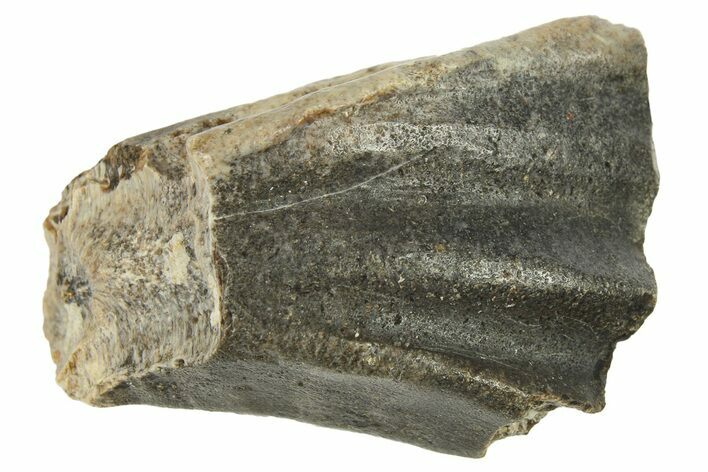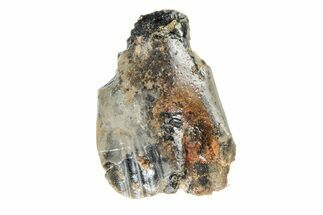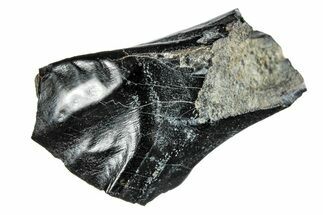1.28" Rare Hadrosauriform Dinosaur (Ouranosaurus) Tooth - Niger
This is a 1.28" long tooth of Ouranosaurus nigeriensis, a hadrosauriform dinosaur known to have roamed Africa during the Early Cretaceous Period. It was collected from the Elrhaz Formation of Gadoufaoua, Niger and was recovered intact, requiring no restoration or repair.
Comes with a riker mount display case.
Comes with a riker mount display case.
Ouranosaurus nigeriensis is a species of basal hadrosauriform dinosaur that lived in what is now Niger and Cameroon during the Early Cretaceous. Its name roughly means "brave lizard from Niger": the first root of the genus name, ourane can mean valor or bravery in Arabic or the Tuareg name for the desert monitor lizard. Its remains were first discovered in the Elrhaz Formation lagerstätten of central Niger in the 1960s, where French paleontologists found fossil evidence of iguanodontiform dinosaurs. Only two complete skeletons have ever been found, and are currently mounted in the Muséum National d'Histoire Naturelle in Paris. Other partial skeletons and fragments are more common.
These herbivores were similar in size and stature to Iguanodon species and are thought to be closely related to that clade. Their skulls were rather small, and they possessed horny beaks and batteries of teeth for chewing tough, fibrous plants. This places it closer in relation to hadrosaurs than iguanodotnians. Like other iguanodontians and hadrosaurs, O. nigeriensis had strong back limbs that could allow it to walk bipedally, as well as shorter front legs ending in fleshy "mittens" with thumb spikes. What characterizes O. nigeriensis best, however, was the large "sail" on its entire back and tail, supported by long and wide neural spines, that gave it an appearance similar to the fearsome predator Spinosaurs. It may also have served as a sort of fleshy hump for storing energy in drier seasons, similar to modern bison or camels.
These herbivores were similar in size and stature to Iguanodon species and are thought to be closely related to that clade. Their skulls were rather small, and they possessed horny beaks and batteries of teeth for chewing tough, fibrous plants. This places it closer in relation to hadrosaurs than iguanodotnians. Like other iguanodontians and hadrosaurs, O. nigeriensis had strong back limbs that could allow it to walk bipedally, as well as shorter front legs ending in fleshy "mittens" with thumb spikes. What characterizes O. nigeriensis best, however, was the large "sail" on its entire back and tail, supported by long and wide neural spines, that gave it an appearance similar to the fearsome predator Spinosaurs. It may also have served as a sort of fleshy hump for storing energy in drier seasons, similar to modern bison or camels.
The Elrhaz formation is an Early Cretaceous fossil formation dating 112-125 million years ago in the Tenere Desert of northeastern Niger. It is mainly known to paleontologists for the Gadoufaoua site, a large fossil deposition painting a picture of the ecology of a wet, green, riverine environment.
The dinosaurs that called this region home include the sail-backed hadrosauriform Ouranosaurus, an herbivore which reached about 28 feet and 2 tons. Nigersaurus, a mid-sized sauropod with a horizontal mouth arranged with dozens of peg-like mowing teeth, would have grazed upon the bounty of greenery in herds that trailed across the landscape. In turn, these large herbivores were hunted by equally large predators.
Eocarcharia was a smaller sized African Carcharodontosaurid, only 20-25 feet long compared to its larger, 40-foot cousins like Giganotosaurus and Carcharodontosaurus. Still, Carcharodontosaurids were formidable predators, hunting with laterally compressed, highly effective cutting teeth. Alongside them were the slightly smaller abelisaurid predator Kryptops. Reaching about 20-23 feet, Kryptops likely used hit and run tactics to wear out prey animals, as opposed to the withering bites delivered by the larger Eocarcharia.
By far the largest predator in the formation, however, was the spinosaurid theropod Suchomimus. Meaning "Crocodile Mimic" for its superficially crocodilian appearance, Suchomimus cleared its competitors' size by a good 10 feet, usually in the realm of 30-35 feet in length and weighing 4 tons. Suchomimus was likely more of a generalist than its spinosaurid cousins. Its body was more suited to wading than to diving. Meanwhile, its size likely made it more than capable of preying on both fish in shallow water and any unfortunate small to mid-sized dinosaurs it may come across.
Notable non-dinosaur fauna from the formation include the super sized Sarcosuchus, a huge crocodylomorph that reached lengths exceeding 30 feet. Other crocodile relatives include the ratlike Araripesuchus, and the broad duck-snouted Anatosuchus. Several fishes called the region their home as well, such as the massive 10- to 15-foot long coelacanth species Mawsonia, and the shark Hybodus.
The dinosaurs that called this region home include the sail-backed hadrosauriform Ouranosaurus, an herbivore which reached about 28 feet and 2 tons. Nigersaurus, a mid-sized sauropod with a horizontal mouth arranged with dozens of peg-like mowing teeth, would have grazed upon the bounty of greenery in herds that trailed across the landscape. In turn, these large herbivores were hunted by equally large predators.
Eocarcharia was a smaller sized African Carcharodontosaurid, only 20-25 feet long compared to its larger, 40-foot cousins like Giganotosaurus and Carcharodontosaurus. Still, Carcharodontosaurids were formidable predators, hunting with laterally compressed, highly effective cutting teeth. Alongside them were the slightly smaller abelisaurid predator Kryptops. Reaching about 20-23 feet, Kryptops likely used hit and run tactics to wear out prey animals, as opposed to the withering bites delivered by the larger Eocarcharia.
By far the largest predator in the formation, however, was the spinosaurid theropod Suchomimus. Meaning "Crocodile Mimic" for its superficially crocodilian appearance, Suchomimus cleared its competitors' size by a good 10 feet, usually in the realm of 30-35 feet in length and weighing 4 tons. Suchomimus was likely more of a generalist than its spinosaurid cousins. Its body was more suited to wading than to diving. Meanwhile, its size likely made it more than capable of preying on both fish in shallow water and any unfortunate small to mid-sized dinosaurs it may come across.
Notable non-dinosaur fauna from the formation include the super sized Sarcosuchus, a huge crocodylomorph that reached lengths exceeding 30 feet. Other crocodile relatives include the ratlike Araripesuchus, and the broad duck-snouted Anatosuchus. Several fishes called the region their home as well, such as the massive 10- to 15-foot long coelacanth species Mawsonia, and the shark Hybodus.
$695
SPECIES
Ouranosaurus nigeriensis
LOCATION
Gadoufaoua, Téneré Desert, Niger
FORMATION
Elrhaz Formation
SIZE
1.28" long
CATEGORY
SUB CATEGORY
ITEM
#283930
We guarantee the authenticity of all of our specimens.
 Reviews
Reviews












